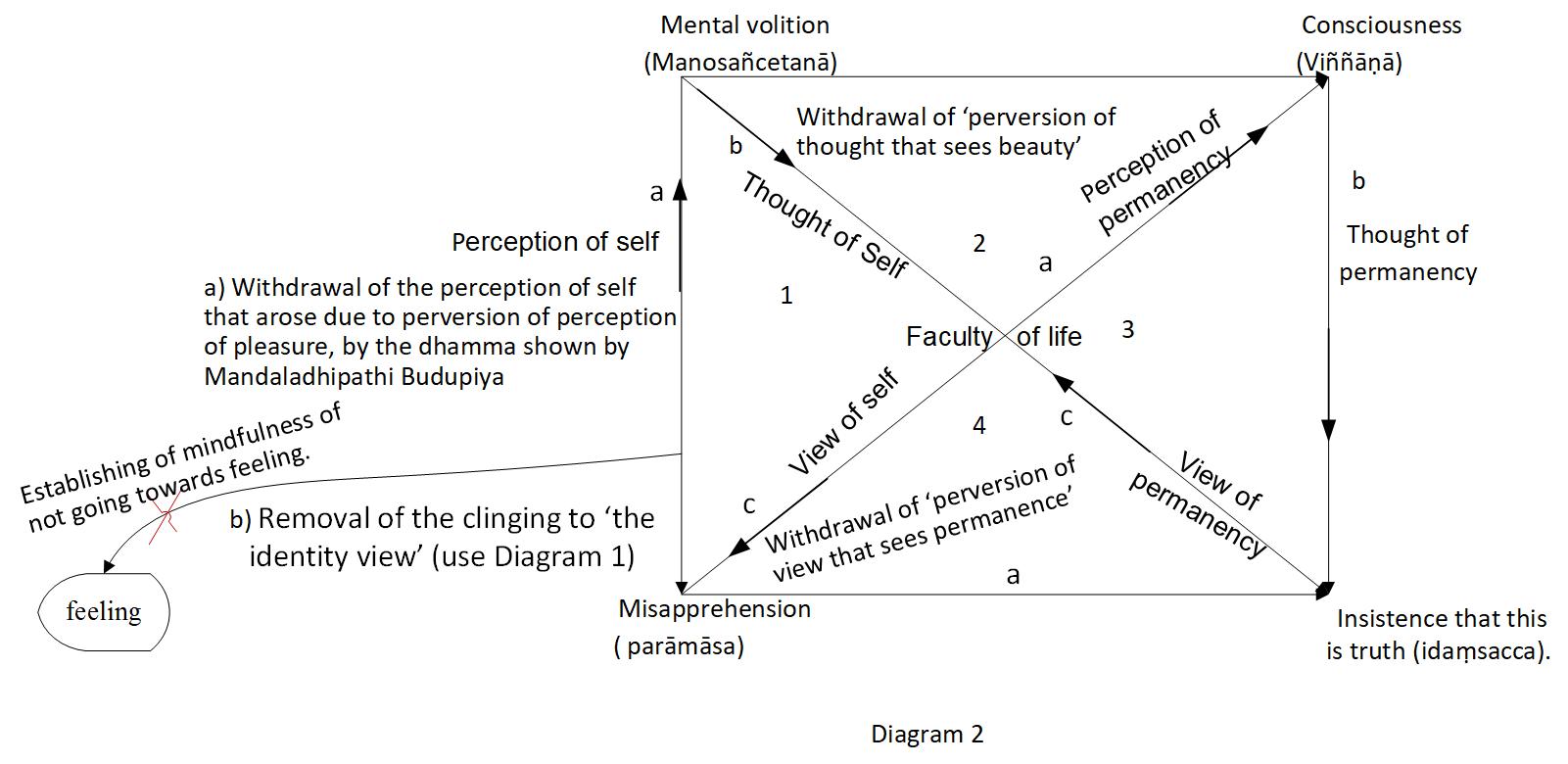The Noble Council of Akanittha Brahma Realm was remembered with faith.
The 04/10/2024 Nibbana meditation was repeated. When Self-1 (attā 1) and Self-2 (attā 2) join in and become conceited for it, wrong view (miccā diṭṭhi) arises. How does right view (sammā diṭṭhi) help prevent this? The understanding of suffering (dukkha) must be strong enough to prevent this joining. The understanding of the origin of suffering (dukkha samudaya) and cessation of suffering (dukkha nirodha) must be strong enough to understand that this does not exist upon joining. How does the Noble Eightfold Path help with this? Whatever dhamma is presented through right view (sammā diṭṭhi), it must help carry forward to nibbana. That is so. Thus, through right concentration (sammā samādhi), the first three of the Four Noble Truths must be maintained.
The above dhamma was further investigated by applying the second case of the 04/10/2024 Nibbana meditation. It was learned that Self-1 (attā 1) becomes strong because even though there are no strong values towards form (rūpa) or feeling (vedanā), there are strong perception (saññā) values towards these doctrines. Even when perceptions (sañña) are strongly present, what happens when combined with the perception of suffering that arises due to Right View (sammā diṭṭhi), and joined with the dhamma principles of the origin of suffering (dukkha samudaya) and cessation of suffering (dukkha nirodha) that show the non-existence of certain phenomena? If this is so, and if Self-2 (attā 2) is weak, meaning if consciousness (viññāṇa) arising from name-and-form (nāmarūpa) is weak, and further if the perception (saññā) and attention (manasikāra) towards previously experienced feelings have faded away, then due to the dhamma principles shown by the second and third noble truths, it becomes clearly evident that there cannot be good feelings, and therefore one does not seek these doctrines of feeling. Thus, birth in the jhāna planes 1 through 4 is abandoned.
How does birth in the 5th and 6th jhāna planes end in the first case, when Self-1 (attā 1) is strong, and Self-2 (attā 2) is strong? Previously, it was discussed that for birth in these planes, feeling values of the name (nāma) portion are used, the right view (sammā diṭṭhi) must be strong enough to prevent covetousness (abhijjhā)(*1). This is accomplished through the first, second and third of the Four Noble Truths. How? Because wrong view (micchā diṭṭhi) is destroyed by right view. That is why. The persistence of consciousness arising due to perception originated from the wrong view (micchādiṭṭhi) is not present here.
Moreover, if the feeling values in the name (nāma) portion become weak, those perceptions (saññā) and attentions (manasikāra) fade away. Here, the perception portion of name-and-form (nāmarūpa) doctrines conditioned by consciousness were examined. Although the second and third Noble Truths show the impermanence of perception, one who hasn't yet understood perception as suffering can still establish on those doctrines when no feeling is perceived. Only when perception is seen as suffering then clinging to identity view (sakkāya diṭṭhi), meaning the [conceit] I am (asmiti)’, is removed, the birth in the seventh jhāna plane can be eliminated. This requires strong mindfulness. This must be deeply integrated into right concentration (sammā samādhi) using Mandaladhipathi Budu Piya's dhamma, as understood in diagram 2; beauty (subha) + permanence (nicca) leading to pleasure (sukha), where beauty (subha) is seen as perversion of thought (citta vipallāsa), permanence (nicca) as perversion of view ((diṭṭhi vipallāsa), and pleasure (sukha) as perversion of perception (saññā vipallāsa).

How is birth in the eighth jhāna plane prevented? That is, while there is no covetousness (abhijjhā) towards both name (nāma) and form (rūpa) portions, and while this doctrine of non-covetousness (anabhijjhā) persists, what causes the cessation of birth? Here, it was investigated what doctrine affects the removal of the ‘conceit I am' (asmimāna). It requires the peaceful, well-liberated mind (shantha suvimutta citta). This should be understood through the 20/09/2024 Shantha suvimutta citta meditation.
That's the meditation I did.
If adding more points to this:
1. When investigating this, as learned in the Nibbana meditation of 30/08/2024, it is understood that when the aggregate of wisdom (paññā khandha) circles around noble concentration (sammā samādhi) for the elimination of ‘conceit of I am' (asmimāna) the peaceful, well-liberated mind (shantha suvimutta citta) arises. This is so.
2. When doing this meditation, at the beginning, arising of rapture (pīti), its spreading throughout the body, followed by pleasure (sukha), and then equanimity (upekkhā), and the arising of the 5th, 6th, and 7th jhānas occurred effortlessly. This happened because of the (prior) preparedness for meditation. Afterwards, progression through these dhamma parts took place.
3. When investigating birth in the 5th and 6th jhāna planes during the first case when Self-1 (attā 1) is strong, and Self-2 (attā 2) is strong, I recalled line c- jhana, d from the avitakka avicāra diagram from the Nibbana meditation of 16/06/2023, and with this, the arising of formless (arūpa) jhāna occurred and they were well maintained. Furthermore, even though various jhānas arise, the mind does not attach to or establish itself in any particular jhāna. That is what needs to be added.

Discussion 26/10/2024
Footnotes added during the discussion
(*1) If adding a bit more to this, one should be skilled in applying the arising and passing (samudaya atthaṅgamaya) towards feeling.